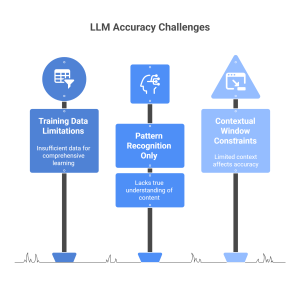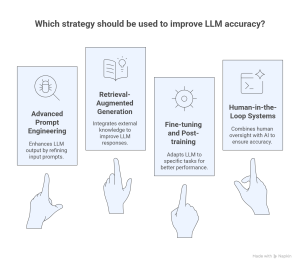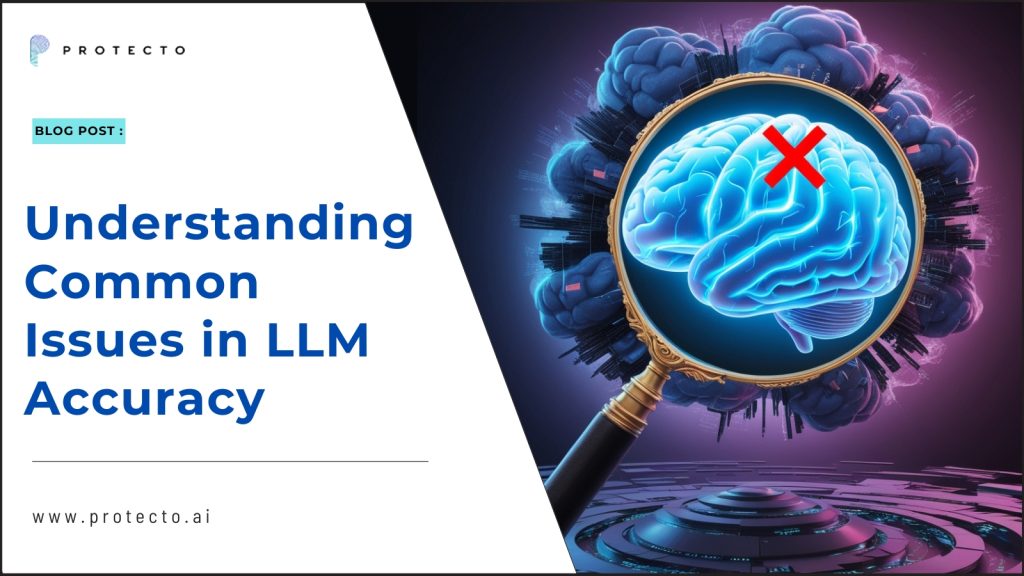Large language models transform how people interact with AI technology. Despite impressive capabilities, these systems struggle with consistent LLM accuracy. Users frequently encounter false information, logical errors, and confused responses.
Many organizations deploy LLM-powered applications without understanding these limitations. The consequences range from minor inconveniences to major business disasters.
Engineers need practical knowledge about accuracy challenges. Recognizing common failure patterns helps teams build more reliable AI systems.
Root Causes of LLM Model Accuracy Problems

Training Data Limitations
LLMs learn from vast text collections gathered from the internet. This approach creates inherent limitations.
The training data contains biases, inaccuracies, and outdated information. Models absorb these flaws during training. They later reproduce these problems in their outputs.
No dataset perfectly represents all knowledge domains. Coverage gaps lead to weak performance in specialized fields like medicine, law, and science.
The internet overrepresents specific perspectives and underrepresents others. This imbalance creates blind spots in model knowledge.
Historical data cannot teach models about recent events. Knowledge cutoff dates limit model awareness about current developments.
Statistical Pattern Recognition vs. Understanding
LLMs recognize patterns in text. They lack a genuine understanding of concepts.
These models predict likely word sequences based on statistical correlations. They don’t grasp cause-effect relationships or logical reasoning.
The text generation process resembles a sophisticated autocomplete. Each word choice depends primarily on previous words rather than coherent meaning.
Without proper comprehension, models struggle with tasks requiring deep conceptual understanding. Abstract reasoning, complex problem-solving, and situational judgment suffer.
This limitation explains why models often produce plausible-sounding but incorrect answers. The text appears valid statistically but lacks factual grounding.
Contextual Window Constraints
LLMs process information within fixed context windows. These windows range from a few thousand to a million tokens.
Limited context prevents models from considering all relevant information for complex questions. They forget details mentioned earlier in lengthy conversations.
Models struggle to maintain consistency across prolonged interactions. They contradict themselves when conversations exceed their context capacity.
The finite context window creates particular problems for tasks requiring the synthesis of extensive documents. Models cannot comprehensively analyze large datasets, lengthy reports, or multiple sources simultaneously.
Common Manifestations of AI Model Accuracy Issues

Hallucinations and Fabrications
LLMs frequently generate false information with high confidence. This phenomenon, called hallucination, represents the most notorious LLM challenges.
Models invent citations, statistics, and facts that sound plausible but don’t exist. They create fictional research papers, non-existent websites, and imaginary experts.
These fabrications often blend seamlessly with accurate information. Users struggle to distinguish truth from fiction without external verification.
The hallucination problem worsens when models address niche topics outside common knowledge domains. Questions about specialized industries, obscure historical events, or technical subjects trigger more fabrications.
Reducing hallucinations remains one of the fundamental accuracy challenges in LLMs. Complete elimination seems unlikely with current architectures.
Mathematical and Logical Reasoning Failures
LLMs struggle with precise mathematical operations. They make basic arithmetic errors in calculations.
Complex logical reasoning presents similar difficulties. Models fail to follow multi-step deductive processes correctly.
These systems often miss logical contradictions in their own outputs. They generate mutually exclusive statements without recognizing the inconsistency.
Abstract reasoning deficiencies also affect programming tasks. Code generation contains logical errors, incorrect algorithms, and security vulnerabilities.
Financial calculations pose particular risks. Models frequently produce incorrect tax calculations, investment returns, and budget estimations.
Temporal Confusion
LLMs exhibit poor temporal awareness. They confuse time periods and struggle with chronological reasoning.
Models mix information from different eras when discussing historical events. They apply outdated regulations to current situations.
Questions about event sequences often receive incorrect answers. Models struggle to establish accurate timelines.
This problem affects forecasting capabilities severely. Predictive questions receive responses based on historical patterns without considering current trends.
Bias and Stereotyping
Training data contains societal biases. Models absorb and sometimes amplify these biases in their outputs.
Responses about demographic groups often reflect stereotypical assumptions. Career recommendations, character assessments, and behavioral predictions show systematic bias.
Geographic biases appear in knowledge distribution. Models know more about Western countries than developing nations.
Language biases affect multilingual performance. English-language content receives more accurate responses than other languages.
Contributing Factors to LLM Performance Issues
Prompt Engineering Challenges
User inputs significantly influence response quality. Poorly constructed prompts lead to inaccurate answers.
Vague questions receive vague responses. Models cannot clarify ambiguous requests without additional information.
The LLM attempts to match the user’s perceived intent. Misleading cues in prompts trigger incorrect assumptions about what information the user wants.
Jargon and technical terminology create particular difficulties. Models may misinterpret specialized vocabulary from professional domains.
Knowledge Cutoff Limitations
All models have knowledge cutoff dates. They lack awareness of events beyond their training period.
This limitation creates obvious problems for questions about current events. Models cannot discuss recent developments accurately.
Less obviously, cutoffs affect reasoning about evolving situations. Regulatory changes, technological developments, and shifting societal norms fall outside model awareness.
Organizations often deploy outdated models without considering these limitations. They expect current information from systems trained on historical data.
Over-optimization for Helpfulness
Model training emphasizes helpfulness. This focus sometimes overrides accuracy concerns.
Models attempt to provide answers even when they lack sufficient information. They prefer generating plausible guesses over admitting knowledge gaps.
This helpfulness bias manifests as excessive confidence in uncertain areas. Models rarely express appropriate levels of doubt when venturing beyond reliable knowledge.
The problem worsens with specialized questions. Rather than acknowledging limited expertise, models produce confident-sounding but often incorrect specialized information.
Evaluation and Detection of LLM Accuracy Problems
Benchmark Performance Assessment
Standard benchmarks measure model capabilities across various tasks. These tests reveal common accuracy limitations.
Reasoning benchmarks show consistent weaknesses. Models score poorly on tests requiring multi-step logical deduction.
Knowledge-intensive benchmarks expose factual reliability issues. Models struggle with specialized domain questions requiring precise information.
Mathematical benchmarks reveal calculation limitations.
Real-world Testing Strategies
Controlled benchmarks miss many real-world failure modes. Practical testing requires additional approaches.
Adversarial testing identifies vulnerabilities. Deliberately challenging prompts reveal accuracy boundaries.
Subject matter expert review catches domain-specific errors. Specialists identify subtle inaccuracies invisible to general users.
User feedback collection reveals emerging issue patterns. Common complaints highlight systematic problems requiring intervention.
Cross-checking responses against reliable sources verifies factual claims. This process identifies hallucination frequencies and patterns.
Red-teaming and Stress Testing
Dedicated red teams find model weaknesses through systematic probing. They identify edge cases where accuracy degrades.
Stress testing pushes models beyond normal operating parameters. Long conversations, complex scenarios, and ambiguous questions reveal failure modes.
Competitor comparison testing benchmarks systems against alternatives. This approach identifies relative strengths and weaknesses among available models.
Strategies for Improving LLM Accuracy

Advanced Prompt Engineering Techniques
Strategic prompting significantly improves accuracy. Several techniques show particular effectiveness.
Chain-of-thought prompting encourages step-by-step reasoning. Models make fewer logical errors when breaking down complex problems explicitly.
Few-shot learning provides relevant examples before questions. These examples guide models toward correct response patterns.
System prompts establish appropriate personas and behaviors. Instructing models to maintain high accuracy standards improves performance.
Structured output formats reduce confusion. Requesting specific formats like tables, lists, or JSON improves information organization.
Retrieval-Augmented Generation (RAG)
RAG systems combine LLMs with external knowledge bases. This architecture addresses many fundamental accuracy limitations.
The approach retrieves relevant information from verified sources before generating responses. This process grounds answers in reliable facts rather than model parameters.
Vector databases store information efficiently for retrieval. Semantic search finds relevant data based on meaning rather than keywords.
RAG particularly helps with domain-specific questions. Specialized knowledge bases provide accurate information about narrow topics.
The architecture also solves knowledge cutoff problems. Regularly updated databases contain current information beyond model training data.
Fine-tuning and Post-training
Generic models benefit from specialized training. Fine-tuning improves performance on specific tasks.
Domain adaptation adjusts models for particular industries. Legal, medical, and financial applications require specialized knowledge.
Supervised fine-tuning with human feedback reinforces accurate responses. Models learn to avoid common errors through correction.
Instruction fine-tuning improves alignment with user expectations. Models become better at following specific directions accurately.
Constitutional AI approaches establish guardrails against known error patterns. Models learn to recognize and avoid problematic output types.
Human-in-the-Loop Systems
Some accuracy problems resist purely algorithmic solutions. Human oversight provides necessary safeguards.
Human validation verifies critical outputs before delivery. Experts review responses in high-risk domains like healthcare, finance, and legal advice.
Feedback loops capture correction data for model improvement. Human editors flag errors, creating training datasets for future updates.
Hybrid systems route complex questions to human experts. Automatic triage sends straightforward queries to AI while directing challenging cases to specialists.
Future Directions in LLM Accuracy
Architectural Innovations
Emerging model architectures promise accuracy improvements. Several approaches show particular promise.
Mixture-of-experts models activate different parameters for different tasks. This specialization improves performance across diverse domains.
Memory-augmented networks retain information more effectively. These systems reduce contextual forgetting during long interactions.
Multimodal models combine text with images, audio, and video understanding. This integration provides additional context for accurate reasoning.
Human-AI Collaboration Frameworks
The future belongs to collaborative systems. Several paradigms demonstrate potential.
Augmented intelligence approaches enhance human capabilities rather than replace them. AI tools support human decision-making with supplemental information.
Expert-guided systems learn from specialists continuously. Professional knowledge transfers to models through structured interaction.
Shared reasoning processes combine human judgment with machine processing power. This collaboration leverages the strengths of both.
The goal shifts from perfect automation to effective collaboration. Success comes through complementary capabilities rather than a complete replacement.




